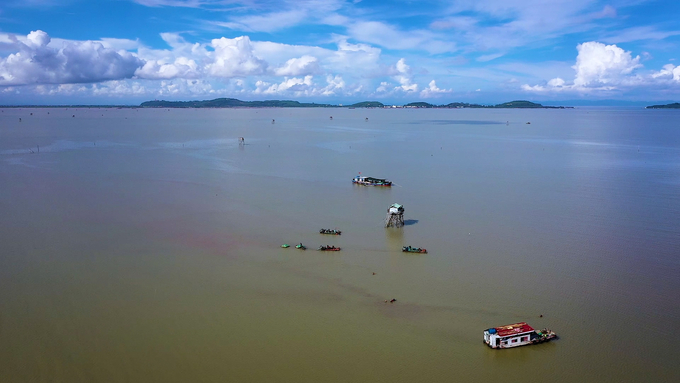November 25, 2025 | 15:09 GMT +7
November 25, 2025 | 15:09 GMT +7
Hotline: 0913.378.918
November 25, 2025 | 15:09 GMT +7
Hotline: 0913.378.918

Vietnam's bivalve mollusk export turnover in the first 9 months of 2023 reached US$ 98 million, down 11% over the same period last year. Of which, clam exports alone reached US$ 62 million. Photo: Quang Dung.
Clam production, exploitation, and processing are gradually becoming an essential source of livelihood for people in coastal areas, contributing to improving income and livelihoods. Mollusks, including clams, are not only popular domestically but are also part of Vietnam's leading seafood export group.
According to the Vietnam Association of Seafood Exporters and Producers (VASEP), Vietnam's bivalve mollusk export turnover in the first 9 months of 2023 reached US$ 98 million, down 11% over the same period last year. Of which, clam exports alone reached US$ 62 million.
The top 9 export markets for bivalve mollusks in our country in the first 9 months of this year are Spain, Italy, Portugal, Japan, America, China and Hong Kong.
In addition, Vietnamese clam products are now present and conquered nearly 60 markets worldwide. With the advantages of domestic production and significant potential for consumption markets, the clam industry is expected to reach new heights.
Many businesses are focusing on investing in technology and constantly improving quality to bring the Vietnamese clam brand to reach, including Lenger Seafood Vietnam Co., Ltd.
The Dutch Lenger SeaFood Group has surveyed in 6 clam farming provinces in Vietnam. Realizing the long-term clam farming potential of Nam Dinh province, Lenger SeaFood Netherlands decided to build a clam processing factory and establish Lenger Seafood Vietnam Co., Ltd. here. Since then, Lenger Seafood Vietnam has continuously tried and accompanied local people and authorities to promote the development of clam farming.

In 2020, Lenger Seafood Vietnam's "Lenger Fam" farming area was certified as the first sustainable clam farming area according to ASC standards in the world. Photo: Quang Dung.
According to Mrs. Tong Thi Luong, Head of the Aquaculture Department, Nam Dinh Fisheries Sub-Department, Lenger Seafood Vietnam Co., Ltd. is the first unit to invest in technology, purchase and process commercial clams in Nam Dinh province for export.
Starting from 2019, Nam Dinh Fisheries Department has worked with other units in the industry to coordinate and support Lenger Seafood Vietnam in linking with farming households in Nghia Hung district to reorganize production towards sustainable clam farming.
By 2020, Lenger Seafood Vietnam's "Lenger Fam" farming area was certified as the first sustainable clam farming area according to ASC standards in the world. This is a highly favorable condition to open new consumption directions for clams.
Mrs. Luong added: "Nam Dinh Fisheries Department has accompanied and supported Lenger Vietnam in applying high technology to the production process. In addition, the two sides have jointly built a high-tech clam seed production project and a clam farming model in ponds. We assess that this project will help improve the quality of clam varieties from the initial production stage, minimizing difficulties and risks when raising clams on tidal flats."
Also, according to Ms. Luong, Nam Dinh Fisheries Sub-Department and Nam Dinh Agro-Forestry-Fisheries and Fisheries Quality Management Sub-Department have deployed monthly environmental monitoring in concentrated clam farming areas. At the same time, implement a food safety monitoring program in collecting bivalve mollusks. From there, Lenger can choose and evaluate product quality most accurately, helping the consumption of clam products improve.
Mr. Nguyen Ho Nguyen, General Director of Lenger Vietnam Seafood Co., Ltd. shared: "The company is one of the pioneering businesses in achieving ASC certification for Vietnamese clams. Currently, Lenger Vietnam has built a 500-hectare clam beach and is the first to receive ASC international certification. We are also developing many other farms to achieve this important certification."
"We realize that the clam export market is very potential, especially the US and Japan. However, these countries all require large clams, about 20-30 clams/kg, which we cannot meet. Clam meat is also a potential product. Previously we could export 4-5 containers to Korea, but in recent years clam prices have increased, so we can now only export 1-2 containers to this market. This is very unfortunate and is also a problem that we need to solve in the near future," Mr. Nguyen confided.
Translated by Tuan Huy

(VAN) An Giang promotes supply-demand connections, standardizes quality and builds value chains, creating a foundation for sustainable bird’s nest development and aiming to expand exports.
/2025/11/24/5339-4-nongnghiep-075331.jpg)
(VAN) Recently, the conference on 'Sustainable Fisheries Linkage Chain - Tilapia for Export' took place in Tien Hai commune, Hung Yen province.
/2025/11/21/4309-2-153400_128.jpg)
(VAN) Green and low-emission rice is paving the way for Vietnamese rice to enter high-end markets, marking the beginning of a transformation journey toward greening and elevating the national rice brand.

(VAN) ‘Right to Win’ outlines a national action plan that shapes a new vision for Viet Nam’s agriculture in an era of renewal and global integration.

(VAN) Lam Dong’s farmed sturgeon output this year is expected to reach 2,300 tons, worth VND 450 billion, affirming the brand’s position on the market.

(VAN) A surge in Ukrainian egg exports, largely driven by soaring sales to the UK over the last few years, has notably pushed up egg prices on the domestic market.

(VAN) The price of Arabica Catimor coffee in Quang Tri is currently at VND 25,000–27,000/kg (fresh cherries), the highest level ever recorded